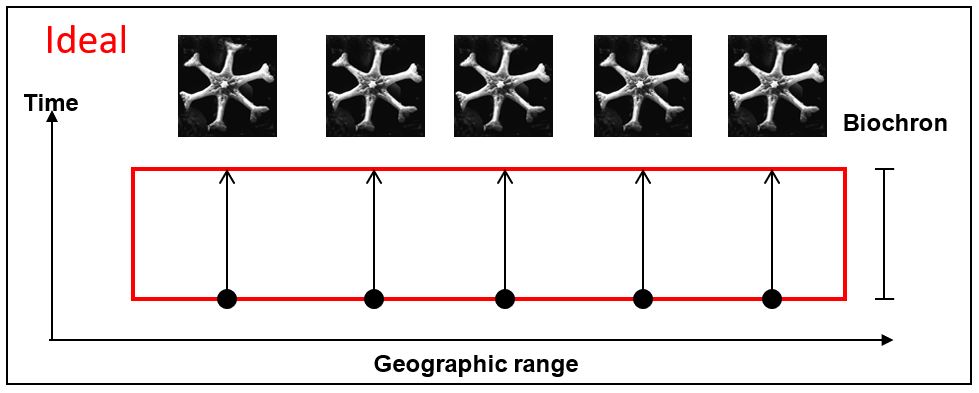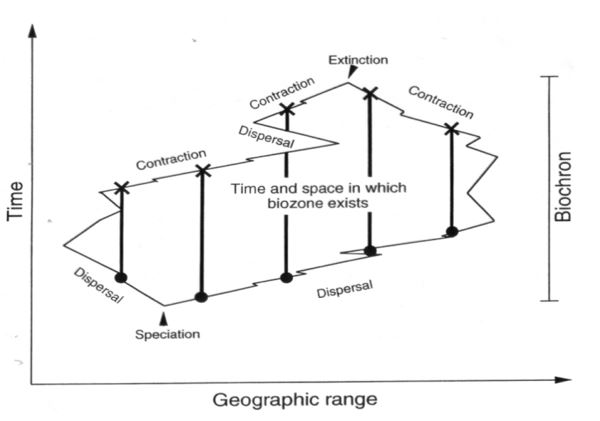Table of Contents
Which Fossils To Use?
It is difficult to think of a fossil group that has not, at some time, been used to biostratigraphically calibrate a particular rock unit – even human fossils and their various accoutrements and accessories have been used. Nevertheless it has become clear to biostratigraphers that some fossil groups are of more practical use then others in global age-dating and biozonation. It is a rare student of geology that is not at least vaguely familiar with at least the mention of using conodonts, graptolites and goniatites in the Paleozoic, ammonites in the Mesozoic and various planktonic microfossils in the Cenozoic.
Although these form a highly disparate group of organisms to use as global correlative tools, they all – more or less – have one thing in common, which is their mode of life. All of the above fossil groups live in the marine realm and, more specifically, they all live above the actual sea floor / sediment substrate. These fossil groups fall into one of two main categories:
Planktonic – organisms which float in the water column and have little or no control over their movements, for example…
- Planktonic foraminifera
- Calcareous nannoplankton
- Dinoflagellate cysts
- Radiolaria
- Graptolites
Nektonic – organisms which float or swim in the water column and have direct, conscious control over their movements, for example…
- Ammonites
- Goniatites
- Trilobites
- Conodonts
This is not to say that organisms which dwell on or within the sea floor / sediment substrate (the so-called “benthonic” realm) do not have any biostratigraphic utility – they do – but their application may be more restricted in geographical range compared with their floating and swimming brethren.
It should also not be taken to imply that non-aquatic organisms are also without biostratigraphic utility. Terrestrial organisms such as plant spores and pollen are equally as important in biostratigraphic correlation in both terrestrial and marine sediments as they can be transported by wind over vast distances.
Why are planktonic / nektonic fossils preferred for global correlation?
An individual fossil species would be “ideal” for biostratigraphy if it had the following characteristics…
- the instantaneous first appearance – worldwide – of the new species
- a short, though measureable, period of existence
- near-global distribution
- universal preservation
- easily identifiable with little or no variation in its appearance
- instantaneous extinction, again worldwide
Such an organism would have a distribution in space and time (called the “biochronal envelope”) like this…

Character of an “ideal” biostratigraphic fossil – short-ranging and widely spread.
Unfortunately, no such organisms exist! In reality, organisms are not so helpful for the poor biostratigrapher. A more typical “biochronal envelope” (the red box above) is more likely to have this appearance…

Biochronal envelope of a more “typical” organism.
…and the characteristics of this organism would be more like…
- the instantaneous first appearance of the new species, but in one geographical location only
- more or less gradual dispersion across various regions but seldom becoming global and with occasional periods where the range contracts
- a variable, though measureable, period of existence in different regions
- inconsistent preservation depending on many other factors
- identifiable, but with some variation in its appearance depending on ecological factors and also perhaps similarities in appearance to ancestral and descendant species, confusing the exact first and last appearances
- variable extinction locations with the final end occurring at one geographical location only, not necessarily the same one as where the species first appeared
At geological timescales, the apparent diachroneity at the beginning and end of a species’ life may be geologically instantaneous and therefore has biostratigraphic value, but it is well to be aware for the possibility that it may be not. In practice, it is usually found that it is the planktonic or nektonic organisms that have distributions in space and time which are closer to the “ideal” biochronal envelope than the benthonic organisms. Why is this?
Planktonic Organisms…
- are quickly dispersed by oceanic currents and, potentially, can achieve near global distribution
- live in an oceanic environment which is relatively more uniform in conditions compared with others
- tend to evolve, live and die out more rapidly leading to shorter stratigraphic ranges
- tend to become extinct over a relatively shorter time span than other organisms
Benthonic Organisms…
- face many environmental barriers to widespread distribution
- live on a substrate, conditions on which can vary widely within the same general environment
- may become locally extinct due to local environmental factors whilst persisting elsewhere
However, even zonation based on planktonic organisms can be subject to spatial and temporal variations due (mainly) to environmental effects:

Standard Neogene planktonic foram zonation showing latitudinal variations (from McGowran, 2005).